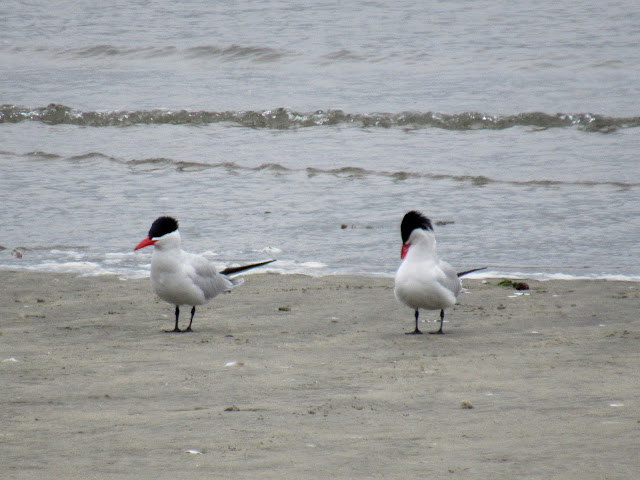Caspian Terns at Moss Landing
Terns are a neat group of birds, and Caspian Terns (Hydroprogne caspia) are particularly eye-catching with their bright bills and dark caps. They are in the same family as gulls, Laridae, though unlike gulls, terns seem to be generally free from the stigma that is usually attached to those ubiquitous birds of the coast. While visiting Moss Landing recently, I spotted (and heard) quite a few terns swooping overhead; I was excited to see a few on the ground, within range of my camera!
The Caspian Tern is the largest species of tern in the world; it is as big as a large gull, and is frequently seen in mixed flocks with gulls. They occur on every continent except Antarctica.
Terns are known for their aerial dives, and Caspians are no different. They fly over bodies of water while looking down to spot fish. When they see potential prey, they dive steeply and plunge into the water in hopes of nabbing a fish. Earlier this spring, at Elkhorn Slough, I watched several smaller Forster's Terns (Sterna forsteri) dive into the water repeatedly after their quarry. It's quite a sight to see!
Caspian Terns breed in colonies, which they defend fiercely. Breeding colonies are found on island beaches in rivers, salt marshes, lakes and other protected bodies of water. Nests are shallow scrapes in the ground, lined with vegetation, shells and other debris.
During the winter months and migration, terns roost on islands and isolated spits of land. Caspian Terns can be found along the coast of central California year round, though their numbers seem to be highest from spring through fall. They prefer protected waters to the open ocean.
The Caspian Tern is the largest species of tern in the world; it is as big as a large gull, and is frequently seen in mixed flocks with gulls. They occur on every continent except Antarctica.
Terns are known for their aerial dives, and Caspians are no different. They fly over bodies of water while looking down to spot fish. When they see potential prey, they dive steeply and plunge into the water in hopes of nabbing a fish. Earlier this spring, at Elkhorn Slough, I watched several smaller Forster's Terns (Sterna forsteri) dive into the water repeatedly after their quarry. It's quite a sight to see!
Caspian Terns breed in colonies, which they defend fiercely. Breeding colonies are found on island beaches in rivers, salt marshes, lakes and other protected bodies of water. Nests are shallow scrapes in the ground, lined with vegetation, shells and other debris.
During the winter months and migration, terns roost on islands and isolated spits of land. Caspian Terns can be found along the coast of central California year round, though their numbers seem to be highest from spring through fall. They prefer protected waters to the open ocean.
Look for Caspian Terns, and other terns, flying high over the water, head angled down searching for fish. Their plunging dives are spectacular and unmistakable. Also listen for terns; like their gull relatives, they can be boisterous and make rather grating calls. You might hear them before you see them!












Comments
Post a Comment